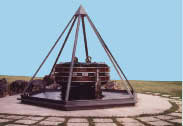One of the central challenges of contemporary nuclear and high
energy physics is achieving an understanding of how quarks and
gluons combine to make mesons, baryons and nuclei.
One particular issue which has received much attention is how the
constituent-parton spins combine to form the spin of the nucleon.
The objective of the first measurements in polarised Deep Inelastic Scattering (DIS) was to determine which fraction
of the nucleon's spin was carried by the quarks. It came as a shock to find that the spins of the quarks inside the nucleon
don't combine to form the nucleon spin as expected from the constituent quark model, but yielded a contribution which was
compatible with zero. These early results from experiments at SLAC and CERN provoked what was called the "spin crises" and initiated
a series of new experiments at laboratories in the U.S. and in
Europe. All these experiments of ever increasing precision confirmed
that the net contribution of the quarks' spins can account for only
a fraction of the nucleon's spin. There must be other substantial
contributions, possibly from gluons exchanged and/or from the orbital
motion of the quarks and gluons about each other.
In this context, strong interest in the new formalism of
Generalised Parton Distributions (GPD) has emerged after GPDs were
found to offer for the first time a possibility to reveal the
total angular momentum carried by the quarks in the nucleon.
HERMES at DESY in Hamburg (Germany) is a second generation experiment
to study the spin structure of the nucleon by measuring not only
inclusive but also semi-inclusive and exclusive processes in polarised
DIS. A comprehensive overview will be given on how to access all the
different contribution to the nucleon spin.
